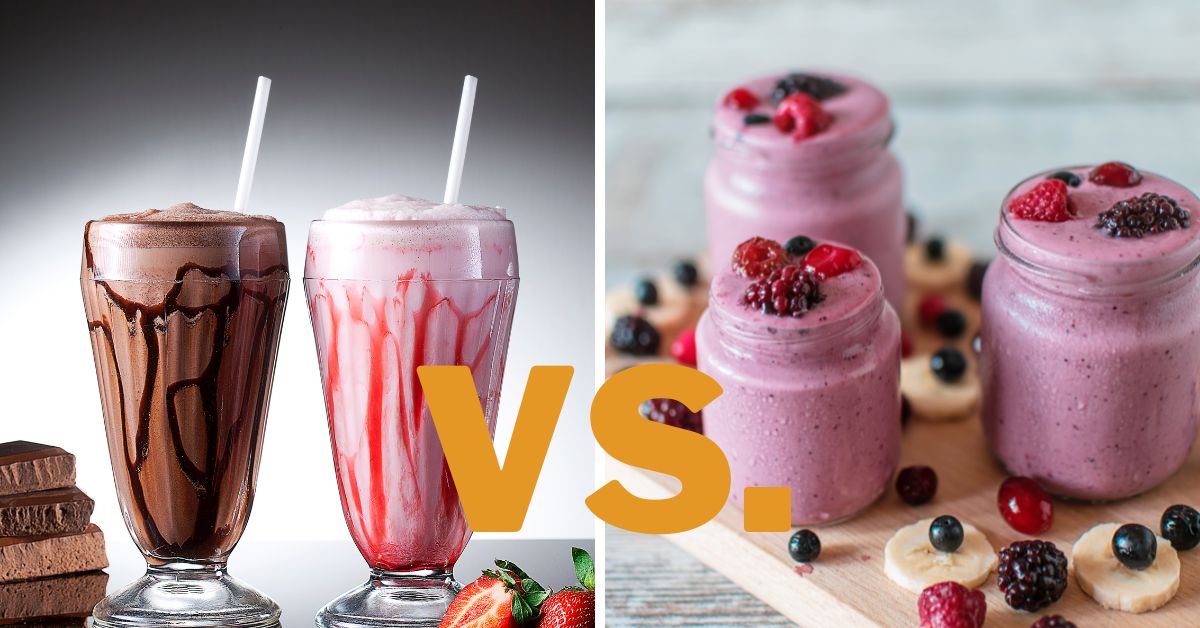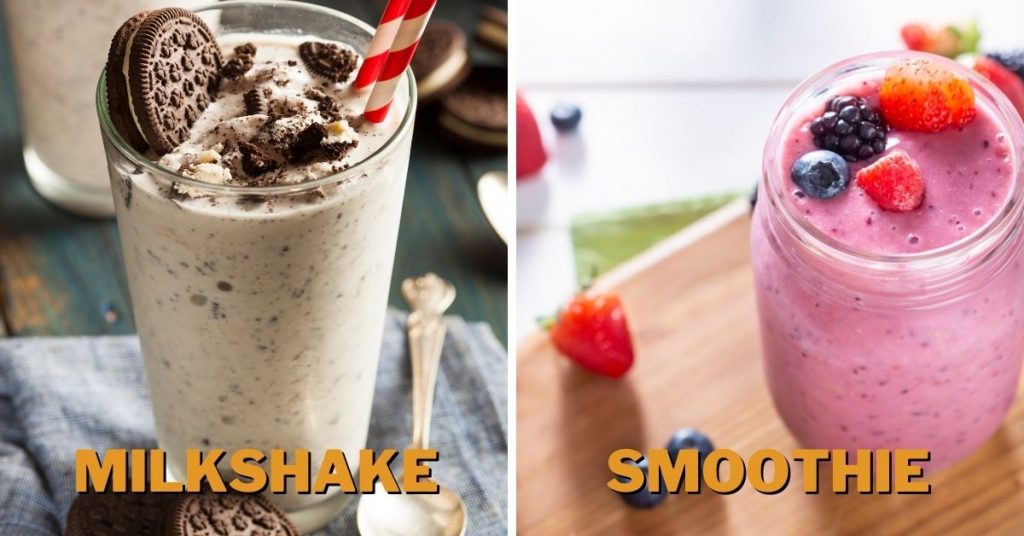Milkshake vs. Smoothie: Differences & Which Is Better?

Smoothies and milkshakes – two beverages that are ideal for cooling down during the scorching heat of summer or after a hard session at the gym. They come in so many different portions and colors. But what is the difference between a milkshake and a smoothie?
A smoothie is a fruit-based drink made by pureeing different fruits, whereas the key ingredients in a milkshake are milk and ice cream. Smoothies typically have a thicker consistency due to the fibers in fruit. Also, smoothies can be naturally sweet, while milkshakes almost always include added sugar.
While the concepts behind these drinks are different, they often share overlapping qualities. As such, it can be confusing to separate one from the other. In this article, we will look at both of these beverages and see how they are made, how they differ in taste and appearance, and how they affect your health.
Milkshake vs. Smoothie: Differences
Before we start with a comparison in detail, here is a cheat sheet to help you out.
| Smoothie | Milkshake |
|---|---|
| Always incorporates fruits and/or vegetables | Always incorporates milk and ice cream |
| Thicker and heavier consistency | Thinner and frothier consistency |
| Can be naturally sweetened with fruits | Usually requires added sugar for sweetness |
| Healthier than a regular milkshake | Can be healthy if you put in the correct ingredients |
Origin
Smoothies
Smoothies first started selling during the 1930s’. The invention of smoothies coincides with the development of electric blenders in the United States. With this new tool, blending and pureeing fruits became much more convenient.
And since smoothies are made from healthy food items in fruits, health food stores on the West Coast of America started producing and selling smoothies. It was not until the 1980s that the term “smoothie” saw use in recipes, and companies started to manufacture beverages with it.
Milkshake
Milkshakes started much differently from the drinks people know and consume today. During the later part of the 19th century, milkshakes referred to alcoholic beverages that contained whiskey, eggs, etc. Another early form of milkshakes was malted milk powder manufactured to feed infants.
By 1900, milkshakes started to refer to drinks made with chocolate, strawberry, and vanilla syrup. Similar to the invention of smoothies, the modern milkshake took its form after the invention of the electric blender in the 1920s. The blender gave milkshakes their now-signature frothy, aerated form.
Preparation
Smoothies
Smoothies typically have three main elements – a liquid, a combination of different fruits and/or vegetables, and some add-ins. The liquid, which can be water, juice, milk, or yogurt, gives smoothies a smoother consistency. You blend your choice of fruits and/or vegetables with the liquid of your choice.
Then you add other ingredients to increase its health value or flavor. Sugar and honey are good ways of making it sweeter. You can add various nuts to give it some crunch. You can also do flavorings such as chocolate syrup, vanilla extracts, almond extracts, etc. After everything is nice and blended, you serve it with garnish and/ or ice.
Milkshakes
As we have already mentioned, the two things you need above all else in a milkshake are milk and your choice of ice cream. Many prefer to use vanilla as it allows you to incorporate other flavors. If you are allergic to dairy, you can always use a milk substitute such as almond milk, coconut milk, rice milk, etc.
Put the right amount of milk and scoops of ice cream in a blender. You can add chocolate bars, sliced fruits, and nuts as well. Blend them until you get a nice and smooth texture.
Just like the smoothie, milkshake is always served cold.
Ingredients
The main difference that separates smoothies from milkshakes lies in their key ingredients. A smoothie is always a fruit-based beverage, and milkshakes invariably combine milk and ice cream. Other than fruits, smoothies also utilize various vegetables, such as kelp, spinach, swiss chard, celery, parsley, etc.
Of course, the two can share similar elements. You can make a smoothie with milk and ice cream. Likewise, you can make a milkshake by incorporating sliced fruit or juice.
This is something you will rarely see in a milkshake. Milkshakes with fruit are common, such as bananas, strawberries, dates, and many more. But a milkshake with blended vegetables is very rare.
Another point of difference can come in the form of sugar. Smoothies are made from blending fruits, many of which tend to be naturally very sweet. So, many people do not prefer to add extra sugar to the mix and just drink it as it is. Milkshakes, on the other hand, almost always incorporate added sugar unless the consumer is someone looking to limit calorie intake.
Taste
Depending on how you prepare them, smoothies will always have a fruity flavor profile. In contrast, milkshakes will invariably have a milky, creamy taste. Since smoothies can be naturally sweetened with fruits, milkshakes tend to be a bit sweeter than smoothies.
Also, thanks to the fibers in the fruit and vegetable, smoothies will have a thicker, heavier texture than milkshakes. Milkshakes are mostly milk and ice cream. So, they do not have much fiber in them, to begin with. Even if you add fruit to the mix, they will still have a lighter, thinner consistency.
Variation
Since their inception, smoothies and milkshakes have seen numerous variations in the classic formula. Some of the more popular versions of milkshakes are:
- Chocolate milkshake
- Vanilla milkshake
- Strawberry milkshake
- Banana milkshake
Some popular examples of smoothies are :
- Banana smoothie
- Strawberry smoothie
- Blueberry smoothie
- Kale smoothie
- Beetroot smoothie
- Green smoothie (consists of many different green vegetables)
- Protein smoothie (used as a protein supplement)
- Mango smoothie
Appearance
You can often tell smoothies and milkshakes apart just from looking at them. Milkshakes are made from milk and ice cream, another dairy product. This gives them a creamy texture and a frothy, airy complexion.
Smoothies, on the other hand, can be creamy and silky. But they often look much denser than milkshakes. Also, smoothies tend to be the same color as the fruits and vegetables in them. So, the color of smoothies can be much more varied than milkshakes.

Nutrition
The nutrients in either drink will vary depending on the ingredients used. That being said, smoothies are generally seen as the healthier of the two as it incorporates actual fruits and/or vegetables. This makes them a great source of many essential minerals and nutrients. [1]
Smoothies tend to use less added sugar than milkshakes, relying more on the natural sweetness of the fruits. So, they are often the choice for people looking to cut down on calories and lose weight. However, many smoothies include sugar and honey, making them as calorigenic as any regular milkshake.
If they incorporate all of the fruit, smoothies will also contain more fibers than milkshakes. Some people will strain the smoothie or use fruit juice to get a smoother texture, which will remove most of the fibers.
Milkshake vs. Smoothie: Which Is Better?
In terms of nutrition, smoothies have a higher potential to be better for the body than milkshakes. If the smoothie is made with actual fruits and uses little to no added sugar, it will be a better source of nutrients and low calories. This makes them ideal for people looking to reduce their weight.
For people with allergies, smoothies are also the most preferable. You can easily make a smoothie using fruits and vegetables you have no allergic reactions towards. But lactose intolerance and allergy to dairy are much more common. And for people with these conditions, milkshakes are pretty much off-limits.
Of course, you can always make milkshakes with non-dairy liquids. But most companies and fast food chains do not feature this convenience. So, you are much better off choosing a smoothie.
Now, fresh fruits may not be available to you at all times. On the other hand, milk and ice cream are much more readily available. So, they can be easier and more convenient to blend than a smoothie.
Additionally, many people prefer the lighter and frothier texture of a milkshake. Smoothies tend to be heavier and less sweet.
Is a Smoothie Healthier than a Milkshake?
While this is not true one hundred percent of the time, smoothies made with real fruits are often healthier than a regular milkshake. Milkshakes can be a good way of drinking milk, a product rich in protein and calcium. [2]
But smoothies can incorporate milk (or yogurt) and various fruits and vegetables to be a complete drink. Also, with the natural sweetness of the fruits, you can make smoothies without adding extra sugar. This can be particularly helpful for losing weight.
Moreover, smoothies can pack a lot of dietary fiber in them. Fibers are a strictly plant property. So, a milkshake made with no fruits or vegetables, a large portion of milkshakes, will have no fibers. And you need fibers for improved digestion and bowel activity.
Now, a great thing about both drinks is that you can tweak and change them to suit your taste and nutritional needs. You can make them as healthy as you want while keeping them palatable.
To conclude, the great thing about both drinks is that you can tweak and change them to suit your taste and nutritional needs. You can make them as healthy as you want without compromising their taste.
